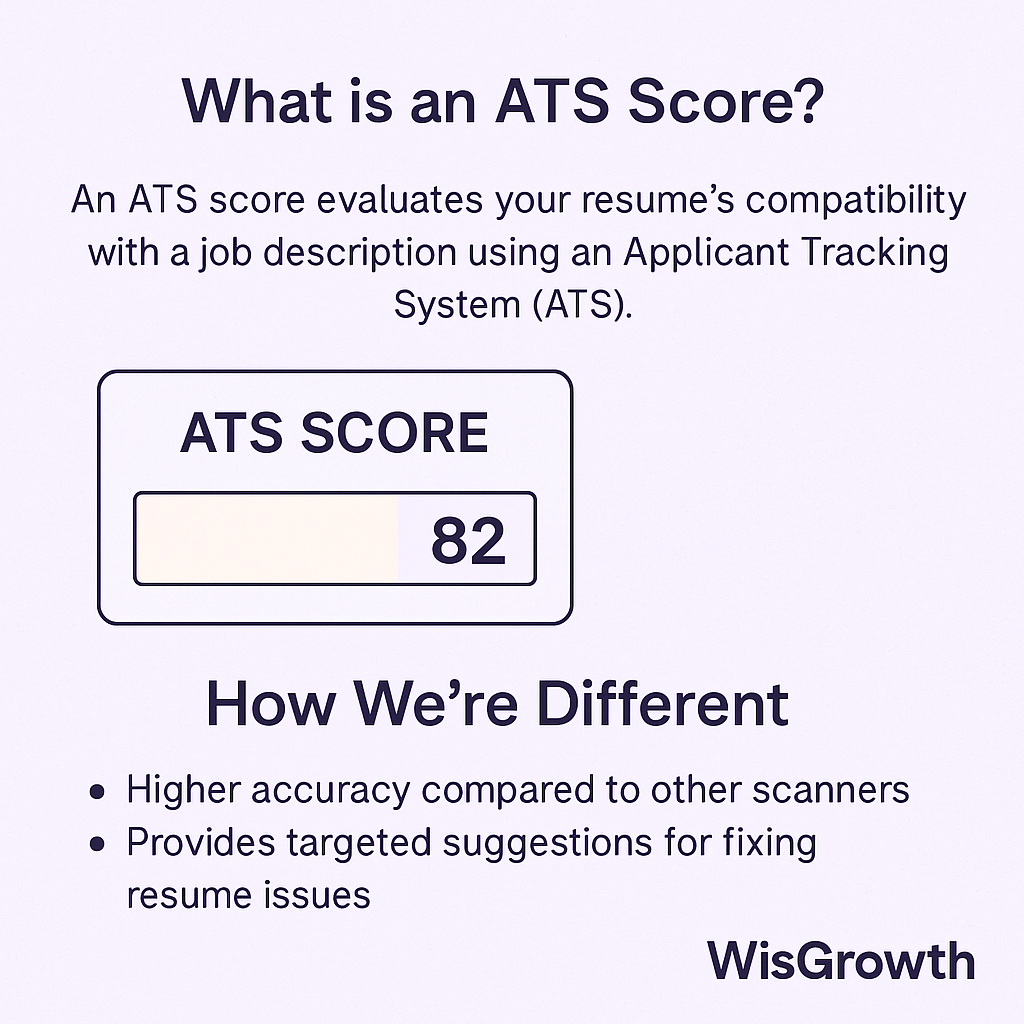What Is an ATS Score & Why It Doesn’t Tell the Whole Story
Feeling invisible in applications? What Is an ATS Score? Why It’s Not Enough (and What | WisGrowth matters—but it’s not your whole story. We’ll help you fix the ATS basics, express real impact, and turn a file into a compelling signal. At WisGrowth, our goal is simple: help you stop guessing and start moving toward a career that serves your life. We’re your clarity companion—practical, honest, and on your side.
What to do next
- Fix the basics: filetype (PDF), simple layout, standard headings, no tables/columns for core text.
- Quantify impact: action verb + what you did + measurable result.
- Tailor once: pick 1–2 roles, extract keywords, reflect them naturally—don’t stuff.
- Scan with our Honest ATS checker, then fix the top 3 issues.
- Add a 2-line ‘Wins’ section showcasing outcomes, not tasks.
💡 Try this next week: Rewrite one resume bullet with an action verb + measurable outcome.
Why we exist: careers shouldn’t be a guessing game. We give you clarity, honest feedback, and a path you can actually follow.
Most scanners give you a number. We give you direction—so humans want to talk to you.

What ATS Really Does
Applicant Tracking Systems parse your resume, index keywords, and help recruiters filter. Helpful, yes—but limited.
- 🧾 Parsing: Extracts titles, dates, employers, skills into fields.
- 🧭 Matching: Looks for role terms from the job description.
- ⚖️ Filtering: May rank candidates or route by basic rules.
Why Many “Free ATS Scans” Mislead
- 📊 Generic scoring not tied to a specific role or seniority.
- 🧩 Overweights exact keywords; ignores synonyms and outcomes.
- 🖼️ Can’t explain why parsing failed or what to change.
Result: false confidence—or unnecessary panic. See Mid-Career Resume Fixes for impact-first rewrites.
How to Read Any ATS Score (Sanely)
| Score Band | What It Means | What To Do |
|---|---|---|
| 0–49 | Parsing/structure issues; missing core terms | Move to a clean single-column layout; add target role terms in plain text |
| 50–74 | Readable but shallow match | Map bullets to outcomes using role language; add synonyms/tool clusters |
| 75–100 | Solid machine match | Sharpen human value: results, scope, and credibility markers |
ATS-Safe Formatting Checklist
- Use standard headings (Summary, Experience, Education, Skills).
- Single column; avoid text inside images, shapes, or complex tables.
- DOCX upload preferred; clean PDF exported from DOCX often OK.
- Job titles, employers, dates in plain text (MM/YYYY–MM/YYYY).
- Fonts 10.5–12pt; consistent bullet style; clear section order.
Keywords Without Stuffing
Mirror target-role language where it belongs—summary, recent roles, skills. Use clusters and synonyms honestly:
- Data: SQL • Snowflake • dbt • BI dashboards
- Product: roadmap • discovery • A/B testing • analytics
- Security: IAM • SOC2 • threat modeling • incident response
Example: From Tasky to ATS-Clean + Impact-Led
Before: “Managed multiple projects with cross-functional teams; responsible for delivery and stakeholder updates.”
After: “Shipped 2 enterprise releases in 2 quarters; 0→120k MAU. Introduced CI and release checklist, cutting lead time ~35% and defects ~40%.”
Now you have plain-text keywords and outcomes recruiters care about.
Why WisGrowth Goes Beyond a Number
- 🔎 Layered analysis: ATS hygiene + job-fit + outcome quality.
- 🧠 Role-aligned prompts: Translate your story to target language.
- 📈 3-step action plan: Fix parsing, add proof, tighten positioning.
Run the Honest ATS Resume Check to get a score and what to do next.
Your resume deserves more than a number.
Make it ATS-clean and human-compelling—so the right people call back.
Scan My ResumePractical checklist
- Pick a role family and write 3 outcome bullets.
- Run an honest ATS baseline and fix parsing issues.
- Ship one tiny artifact this Friday.
- Send 5–8 calibrated messages; track replies.
- Reflect for 15 minutes on Sunday and pick the next smallest step.
How we support your next step
We won’t drown you in dashboards. Expect gentle nudges, realistic parsing checks, and a clear way to prove value—week after week.